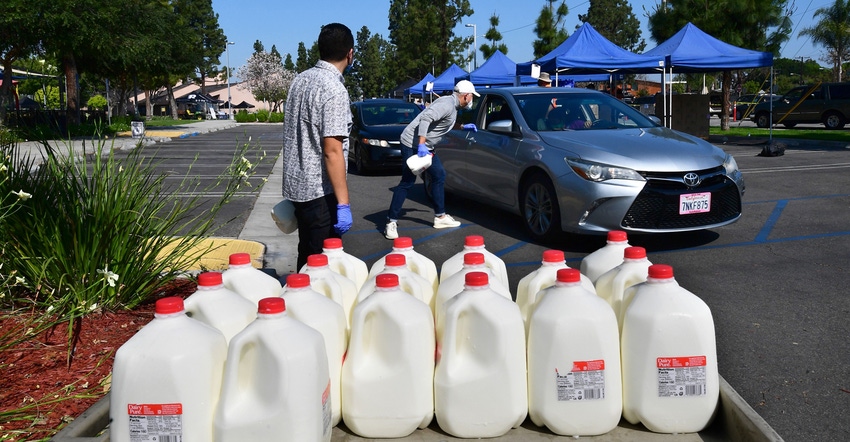November 3, 2020

It may be a while before anyone associated with the dairy industry forgets what happened in 2020.
This year started out with considerable optimism, but that quickly was turned on its head as the outbreak of COVID-19 swept across the world in February and March. The U.S. went into a sudden lockdown that caused dramatic shifts in consumer behavior.
Employee furloughs, restaurant shutdowns and school closings shifted food demand toward more in-home eating. Grocery stores saw a surge in sales. In fact, dairy retail demand was so strong that many stores implemented rationing for some products like butter, cheese and fluid milk.
This year will be remembered for its wild price plunges and runups that led to an extreme divergence of base Class I and Class III prices. This created negative producer price differentials (PPD) and incentivized depooling in many Federal Milk Marketing Orders in June and July.
Prices returned to normal in August, but recent runups in cheese prices will likely push October’s Class III high enough to again generate a negative PPD and motivate some plants to consider depooling.
Fortunately, the dairy industry is resilient. Government officials, dairy cooperatives, business leaders, regional associations, academia and food banks all stepped in to bolster the industry like never before. One program that’s been very beneficial has been USDA’s Farmers to Families Food Box Program, first announced April 17 as part of the Coronavirus Food Assistance Program (CFAP).
Under the direction of USDA’s Agricultural Marketing Service (AMS), the program directed food boxes of fresh produce, meat, eggs and dairy products to be assembled by distributors for transport to foodbanks, community organizations, nonprofits and faith-based organizations.
In a recent article, IDFA’s Michael Dykes said that USDA had purchased nearly $1 billion in dairy products since mid-May. He also pointed out that at least one-quarter of the food box content is dairy products. Indeed, a significant amount of the milk supply has safely moved to the consumer through the program since April. Some reports show that 8% or more of the nation’s cheese has moved through this program.
A second round of CFAP, called CFAP 2, was recently announced and sign-ups began Sept. 21. Dairy is among several other agricultural sectors that qualify for the program. Under CFAP 2, dairy direct payments will be made equal to $1.20 per cwt on eligible milk production for the final nine months of the year. Sign-ups will be accepted through Dec. 11 and should be made at USDA-FSA county offices.
CFAP 2 is considered a separate program from CFAP and requires its own sign-up.
Exports and trade
Dairy product exports have been surprisingly strong to Asia, specifically the Philippines, Thailand, Indonesia and Vietnam. Trade officials are working on deals with African nations and India, which could open significant markets for U.S. dairy products.
According to Tom Vilsack, president and CEO of the U.S. Dairy Export Council, skim milk powder exports to Southeast Asia rose by 72% during the first seven months of this year compared to last year. In the past 25 years, U.S. dairy exports rose 511% from $982 million to $6 billion. Today, one in seven tankers leaving the farm ends up in an export market somewhere.
U.S. trade officials and members of Congress continue to pressure Canada to live up to their obligations for dairy under the terms of the U.S.-Mexico-Canada Agreement.
A bill has been introduced in Congress called the Dairy Pricing and Policy Commission Act of 2020. This bill would require the USDA secretary to form a commission consisting of a cross section of representatives from all areas of the dairy industry to address the issues and challenges within the industry, including Federal Milk Marketing Orders. The commission will conclude its work in two years with a full report to Congress.
Strong production and prices
Despite the pandemic, U.S. milk production has been strong, with noteworthy gains every month this year except for May. The latest USDA report shows milk production was up 2.4% in the top 24 selected states. Most Northeast states were up compared to last year except for Vermont. New York was up 1.4%, Pennsylvania was up 1.9%, Ohio was up 4.6% but Vermont was down 5.5%.
Both barrel and block cheese prices have skyrocketed, with blocks climbing to a weekly average near $2.80 a pound. USDA’s announcement of a fourth round of the food box program could keep cheese markets firm and raise prices. Many restaurants and schools are reopening, retail sales remain brisk, and export demand is strong. All these factors should help keep dairy prices higher.
USDA has raised its latest forecast on cheddar cheese prices, which translates to a Class III price of $18 per cwt, up 75 cents from the previous month’s forecast. Higher forecasts for nonfat dry milk prices raise Class IV up 10 cents to $13.50 per cwt. The 2020 all-milk price forecast is now $18 per cwt, up 25 cents from the previous forecast of $17.75 per cwt.
For 2021, USDA has raised all prices on cheese, whey, butter and nonfat dry milk due to improving market conditions. These higher price estimates have generated a 2021 forecast of $17 per cwt for Class III, up $1 over the previous forecast. Class IV for 2021 is raised 50 cents to $14.10 per cwt. The all-milk price forecast for 2021 has been raised to $17.60 per cwt, up 60 cents from the previous forecast.
It should be noted that the 2020 Class I base price through November has averaged $16.64 per cwt, which is 14 cents less than the previous year. That is not bad considering what the industry as well as the entire country have been through this year.
Latta is a political and economic consultant for Northeast Dairy Foods Association Inc.
About the Author(s)
You May Also Like




